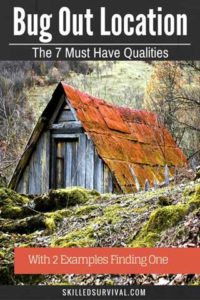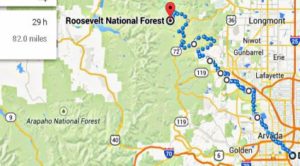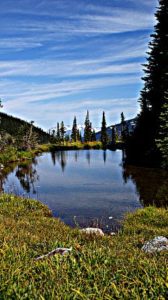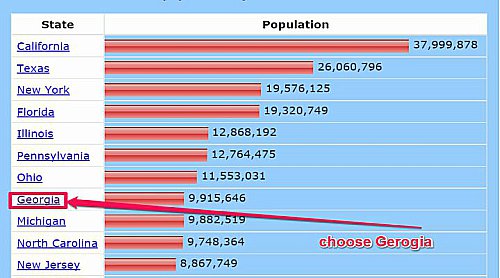
A Complete Guide to Finding (& Buying) A Bug Out Location
Because finding a terrible one is easy.
Just setup shop anywhere and suffer whatever consequences that will bring.
While finding an amazing location takes Hard Work, Time, Research and Dedication.
But that’s what YOU want, right? A safe place you can run to when the world goes sideways.
With my help you’ll avoid making a costly mistake and find a perfect location that’s RIGHT for you!
TOPICS IN THIS GUIDE… ↓(click to jump)

Want a free 104 item bug out bag checklist?
Enter your email below to instantly download this Complete Checklist PDF. No purchase necessary. 👇 👇7 Tips For Finding An Ideal BOL
To find the best locations, you must make wise choices.
A checklist can help with that:
↓ My Checklist For Finding The Perfect Bug Out Location
1. Distance
There are two primary aspects to figuring your total bug out distance, and they both oppose each other.
- Your entire bug out travel distance
- Your bug out location’s distance from dense populations.
With your travel distance, you want to keep it as short as possible.
The further you must go the more opportunities to run into problems.
Depending upon the SHTF event, roadblocks could be set up within hours.
↓ Where To Bug Out: A Survival Guide
The second aspect is the proximity to high-density populations.
I’ll make this one relatively easy, don’t pick in a Danger Zone County.

Want a free Danger Zone County Report?
Click here to download this report and see if you're in a Danger Zone County (or not). No purchase necessary.Now that we’ve identified two primary aspects to your bug out distance, let’s discuss in more detail….
If you’re purchasing land to serve as a bug out property, you must calculate the distance from your current home.
Your Travel Distance = The total distance from your current home to your bug out location.

Example Of A Bad Walking Bug Out Route
If walking, try to keep it within a five-day travel distance.
At a max of about 12 miles per day (trust me, that’s a lot).
You’re looking at a location that is no more than 60 miles from your takeoff location.
Side Note: Make sure you buy a good bug out bag for this trek.

Want a free 104 item bug out bag checklist?
Enter your email below to instantly download this Complete Checklist PDF. No purchase necessary. 👇 👇If you are driving, plan to go only as far as a single fuel tank will take you.
If you plan anything further, put together a long-term bug out fuel storage plan.
One without relying on gas stations.
But regardless of how much fuel store, it’s not advisable to attempt a multi-state travel.
Traveling THAT far takes a lot of time (especially if you are avoiding the jammed interstate system).
And it adds lots of potential run-ins with unfriendlies along the way.
You must honestly ask these two questions:
- Do you believe you can get from your current location to your bug out location safely during a crisis?
- Is the location a safe distance from high-density populations?
If you can confidently answer both of these questions in the affirmative, then that location is one worth further investigation.
If not…move on and keep searching.
2. Water Availability
Ideally, you want a natural water source on your property.
Why? Because you can’t survive long without it.
So why would you choose a property that puts you at direct odds with the most crucial survival resource?
Unless you have a massive water self replenishing storage system (a.k.a. large storage tanks and rainwater collection systems), you’ll want a pond, lake, river, or stream nearby.
For those who plan to bug out in the desert, your BIGGEST challenge is water procurement…
If this is you, check out this device that creates water from the air.
For everyone else, purchase land with water on it.
The most obvious benefit of water is to consume it.
However, if water is abundant, it can go way beyond just hydration.
Water is also necessary for sanitation and is great for constant power generation purposes (running water only).
If you have running water moving down a slope at a decent speed, you can harness the energy by setting up a hydro-power generator.
Don’t discount this potential; small hydroelectric setups can run a basic homestead.
So the water challenges to overcome are:
- Are there any water resources on (or very near) the property?
- How reliable is this water source?
- Is it seasonal or available all year? (you don’t want a trickling stream to dry up at the first signs of mild drought.)
Bonus points if the water source has enough kinetic energy to generate power.
↓ The Problem with Lakes & Ponds as Bug Out Locations ↓
3. Keeping Your Bug Out Location Concealed
Even if you choose your bug out location is a highly remote area, far away from high-density cities…
Unfriendly people may still stumble upon your hideout if you’re not careful.
You found the location, so there’s a good chance other people will find it as well.
Try to find areas far away from obvious paths of travel.
If you are looking for a location in the mountains, don’t forget to choose one nowhere near a mountain pass.
That’s the EASIEST path where people naturally want to travel.
If it’s challenging for you to get to the survival location, then that’s a positive thing for concealment.
Your odds of someone else stumbling upon your location are much lower.
Once you buy the land and set up a cabin, shelter, RV, or tent, make certain it blends in with the surroundings.
That way, wanderers can’t see it from a distance.
Will smoke and scent from a fire be detectable to other people from miles away?
Keep your fires contained and only light them at night to hide the smoke.
According to SurvivalistPrepper:
Even if you live in a semi-rural or rural area the smell of your cooking will carry very far, in some cases more than ½ a mile away.
Also, investigate how easy it will be to watch and defend the property.
You don’t want to be in a poor defensive position should a group of bandits decide to attack.
To quote a good article from PrepForSHTF on this topic:
Defending your bug-out location or safe haven and possessions during a crisis is new territory for most people, and if you do not have specific training in defense or offense tactics then it is likely you will lose your supplies or even your life if you try to barricade yourself inside and fight it out.
It’s always best to avoid a conflict in the first place (i.e., concealment).
Now, concealment and water availability can sometimes be at odds with each other.
People are drawn to water for obvious reasons.
And they will either follow rivers and streams or look for ponds.
However, do your best and know a property’s strengths and weaknesses to plan accordingly.
↓ How to Defend Your Property from THE PURGE! ↓
4. Self-Reliance Opportunities
Some form of basic grid-independent power generation is a huge bonus for a survival property.
I touched on a power generation option earlier, but solar power should also be considered…
Investigate further in regions with reliable amounts of direct sunlight.
You’ll also want to look for nutrient rich soils.
Growing a garden will be challenging if it’s all rock.
Abundant firewood will be helpful to heat your shelter and cook your food.
- Can you raise any livestock for food on the property?
- Is there enough grass to keep goats?
- Can you grow food to support chickens?
- How prevalent is wild game or fish?
All these food and water considerations add up to either a good survival bug out plan or a nightmare.
↓ Why did I buy land in West Virginia as my bug out location? ↓
5. Land Property Costs
As a realist, property cost will always be an issue.
I wish we could all find bug out properties for under $3000, but that’s unrealistic.
The truth is:
The best ones will cost more.
So you’ll have to balance each one of the 7 qualities to find one that will work within your budget.
However, if you plan to squat on some remote public land, the property costs aren’t really an issue.
↓ Overlooked Affordable Bug Out Locations

Want a free 104 item bug out bag checklist?
Enter your email below to instantly download this Complete Checklist PDF. No purchase necessary. 👇 👇6. Government Red Tape For The Land
Double-check any zoning requirements to build structures, grow crops or raise animals.
After SHTF the government might not be following up anymore (they’ll have bigger things to worry about).
But until that day comes…they will.
To get your survival location setup before SHTF, you want to avoid dealing with much red tape.
So it’s best to investigate this before you sign on the dotted line.
7. Land Location and Natural Threat Potential
As you can see from this map, there are very few areas in the US where you’re not in a high-risk zone for something…
You might find a good location with a large stream running through it.
- But what’s the possibility of water from that stream flooding your new bug out cabin next spring?
- Is the location in tornado alley?
- Are wildfires a concern?
Take a look at all these factors based upon your proposed location.
While this factor alone shouldn’t deter you from purchasing a good bug out property it should be a consideration.
There may be ways to mitigate the natural threats once you build your shelter.
- Maybe you build the structure higher up on the hill than you originally intended to avoid any flooding potential.
- You could clear some land surrounding the home to make it a defensible area and have a better chance of surviving a wildfire.
- You might build your bug out cabin with better fasteners or keep it lower profile to stand up better against high winds.
Once you have secured your survival property, you must plan how your future homestead will operate.
↓ The Best Places To be When SHTF: Strategic Relocation
How To Find Private Locations For Sale
You can find bug out location ideas online.
Start with a couple of rural land websites.
You can filter your search by area, type of land, and price.
Let’s go through an example, shall we…
For grins, let’s say I live in the metro Atlanta area (I don’t)
First, I would start looking for the most sparsely populated counties in Georgia.
Find Georgia and click it.
Looks like the least populated county in Georgia is Taliaferro County. This is based solely on absolute population – make sure to consider density, too which is absolute population divided by square miles.
Now, I have no actual experience in this area…
And it might be a terrible selection.
I see that Taliaferro is a county located between Atlanta and Augusta.
So it might not be “ideal” but this is as good a place to start your search as any.
The bug out location distance is about 95 miles from the heart of Atlanta.
So it might be a bit out of reach for a hiking bug out unless you live significantly East of Atlanta.
In this case, a good bug out vehicle is recommended.
So let’s roll with it and see what we find.
Enter Taliaferro County into one of the three rural land websites and hit the big red search button.
Now scroll through the results until you find something worth exploring further.
This bug out property seems to have some potential.
It’s a price that some people might be able to afford.
It’s 5 acres, providing some defensible space to work with.
It sounds like there’s water potential with a creek bordering the rear of the property.
If coughing up 11k seems like a pipe dream, then maybe you can team up.
One often overlooked aspect of survival is creating a trustworthy survival coalition.
- Maybe you have some extended family or close friends who are also preppers.
- Maybe they would jump at the chance of teaming up to purchase a good bug out property together.
- You could build several small cabins on a 5-acre parcel of land.
- If you found one family member and a couple of friends, you might get access to this property for only $2,750.
Yes…that’s still not free, but it looks much more affordable when you team up.
Plus, if you team up with a group of like-minded friends, you’ll all have higher survival rates when SHTF.
That’s how I would start my search for a private location to purchase.
I would do this several times and come up with a list of several properties to visit.
Never, ever buy a property sight unseen.
I’ve heard of people doing this when they find a great deal online, which typically results in major disappointment.
Find a buyer’s real estate agent you trust and go see the properties with your own eyes.
Another place I’ve seen some interesting bug out property listings is Craigslist.
I saw a potential bug out property about a month ago selling for 5k in a remote location in Colorado.
Now again, buyer beware…
Most times, these lower-priced survival locations are priced that way for a reason.
It’s your job to find out why the price is reduced and then determine whether that’s a deal-breaker or not.

Want a free 104 item bug out bag checklist?
Enter your email below to instantly download this Complete Checklist PDF. No purchase necessary. 👇 👇How to Find Public Bug Out Land Options
Maps.
I always start with maps.
I love topographical maps.
Get some topo maps of the remote government lands that surround you.
My favorite topographical maps are National Geographic’s Trails Illustrated Series.
They are the right size, have the right amount of detail, and are waterproof.
I highly recommend buying one for your area.
Side Note: I like National Forests more.
I’d avoid National Parks.
National parks are too busy and have too many full-time park rangers constantly patrolling the backcountry.
Topo maps provide crucial terrain detail.
They are necessary to hunt for a worthy location.
I look for remote areas with as many of the 7 bug out location essentials I described above.
The good news is…you can begin this search online with Free Online Topo Maps.
http://www.digital-
If you visit this website, here’s what you’ll find.
You have zoom controls on your left, and make sure to pick “My Topo” in the upper right-hand corner.
Let’s say we are looking for some land in Northern Georgia (Chattahoochee National Forest)…
Here’s what a topographical map of this area looks like.
I focus on areas with water nearby, but getting to it is also a pain.
Some rough service roads might be nearby, but I’d avoid anything near a paved highway.
Mark up some potential survival locations and then schedule some time to visit them.
Plan some overnight camping trips to these remote locations to scope them out.
Once you find a decent, free location, you can begin forming the rest of your plan.
Figuring out such details as your overall bug out distance, caching, shelter, homesteading, etc.
If you have an RV or camper, that might work if you can drive to the location.
Otherwise, you might need to start stocking supplies (caching) in your new bug out location (hide it well).
Also, make certain your bug out bag, bug out bag checklist, and bug out plan are 100% ready to go.

Want a free 104 item bug out bag checklist?
Enter your email below to instantly download this Complete Checklist PDF. No purchase necessary. 👇 👇Why Trust Skilled Survival...
Go here now to review a full breakdown of:
- Who We Are
- Our Credentials
- Our Mission
- & Product Recommendations...
Here are a few highlights of our teams credentials & certifications:
- Certified Member of a Mountain Search & Rescue Organization
- Plant Emergency & Safety Leader for a Major Food Manufacturer
- Member of the 10TH Mountain Division Hut Association
- Certifications: Avalanche 1, WFR, CPR
- Official Gear Tester for Numerous Outdoor Gear Companies
- Countless Multiday Backpacking trips into Remote Wilderness
- Bachelor's Degree In Mechanical Engineering
- Bachelor's Degree In Civil Engineering
- Bachelor's Degree In Biomedical Engineering
"It takes 20 years to build a reputation and five minutes to ruin it." - Warren Buffett
We're fully aware that trust is NOT something you GET but is EARNED.
And we'll continue to earn YOUR trust through our forthright and honest approach with each new Blog Post, Guide & Product we create...
Prepare, Adapt & Overcome,


AND... I've still got a few gaps in my preps...🤔 But at least, I'm not part of 'The Fragile Masses'. 👍 Find out where YOU stand by answering a few questions...

Recommended Reading
Best Bug Out Bags: The Most Reliable Pack Experts Trust
You deserve a bug out bag you can trust; a pack to protect all your gear. Here's how to find a good one and avoid making amateur mistakes.
Bug Out Bag Weight: How To Reduce Every Deadly Pound
10 advanced tactics to reduce your bug out bag weight because a heavy bug out pack will slow you down. And a slow getaway can get you killed.
Bug Out Vehicles: The Best Setups To Escape The Chaos
A good bug out vehicle will help you make it out of chao to safety FAST. I show you the best options and capabilities to design your own rig.
Bug In Vs Bug Out? Smart Or Guaranteed Death Trap
One of the hardest SHTF decisions is: Bug In vs Bug Out. You should plan for both because there some situations where you may have to leave.
Bug Out Bike: THE Most Reliable Way To Escape
A simple 6 step action plan to turn a regular bike into a badass, terrain crushing bug out bike - to escape the chaos without traffic jams.
Best Survival Retreat: How To Secure Your Own Safe Haven
Building your own survival retreat is easier and more affordable than you think. Log cabins, dug outs, adobe huts are all great options.














